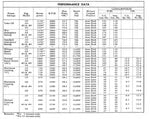...
As for ".../aircraft models" I meant new variants of the 109 and 190. I possibly could have left that qualifier out of the discussion but I do not know how much it would take to fit a 2-stage DB engine into a 109,
...
The Bf 109K-14 was supposed to used DB 605L. The 605L was slightly wider than 605D where supercharger was installed, otherwise it used same 'power section'.

